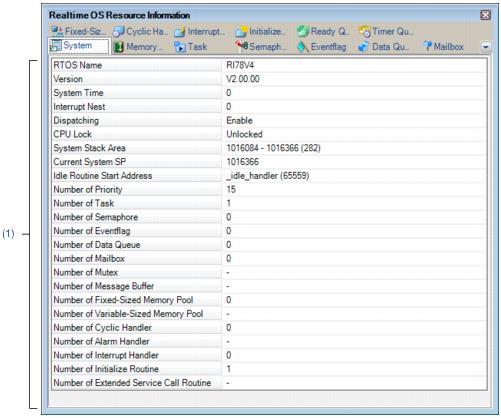|
|
Displays cascade menus for selecting the header items to display.
|
|
|
|
The following items are displayed for selection.
RTOS Name, Version, System Time, Interrupt Nest, Dispatching, CPU Lock, System Stack Area, Current System SP, Idle Routine Start Address, Number of Priority, Number of Task, Number of Semaphore, Number of Eventflag, Number of Data Queue, Number of Mailbox, Number of Mutex, Number of Message Buffer, Number of Fixed-Sized Memory Pool, Number of Variable-Sized Memory Pool, Number of Cyclic Handler, Number of Alarm Handler, Number of Interrupt Handler, Number of Initialize Routine, Number of Extended Service Call Routine
|
|
|
The item in question will be displayed.
|
|
|
The item in question will not be displayed.
|
|
|
Displays cascade menus for selecting the display notation.
|
|
|
|
The following items are displayed for selection.
System Time, Interrupt Nest, System Stack Area, Current System SP, Idle Routine Start Address, Number of Priority, Number of Task, Number of Semaphore, Number of Eventflag, Number of Data Queue, Number of Mailbox, Number of Mutex, Number of Message Buffer, Number of Fixed-Sized Memory Pool, Number of Variable-Sized Memory Pool, Number of Cyclic Handler, Number of Alarm Handler, Number of Interrupt Handler, Number of Initialize Routine, Number of Extended Service Call Routine
|
|
|
Displays value in signed decimal number.
|
|
|
Displays value in hexadecimal number.
|
